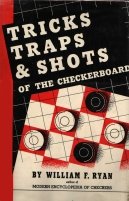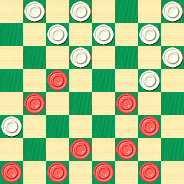Dick's Gambit

The photo above is of an iceboat named Dick's Gambit. It was taken by Michigan photographer Rick Wolanin, and is used with his kind permission. (You can see more of his work here.)
We can understand why the boat bears the "Gambit" moniker; ice-boating is a pretty wild and wooly endeavor. After all, a "gambit" is a deliberate risk taken in the hope of gaining something in return.
There are gambits in checkers, too; there is even "Dick's Gambit" although in this case we refer to checkerist George Dick. Willie Ryan featured Mr. Dick's gambit in Tricks Traps & Shots of the Checkerboard, and we're reprinting Willie's words for you today.

"As a general rule, an early losing move, when properly met, causes the game to deteriorate rapidly. The numerous early losses illustrated in this book prove that. However, there are some exceptions to this rule, as in the game below, where white makes a losing move on the eighth turn, yet is able to keep the game going for a long time, on the very fringe of tenability, only to succumb in the end to black's exacting play.
| 11-15 | 5-9 | 11-16 |
| 24-19 | 25-22---A | 18-15---E |
| 15-24 | 8-11 | 10-19 |
| 28-19 | 30-25---B, C | 22-17---F. |
| 9-14 | 12-16*---D | See the |
| 22-18 | 19-12 | diagram. |
A---A losing move---1. Although white is lost on the eighth play, with 22 pieces still on the board, this is one case where you can't count your checkers until they're hatched. The usual continuation for a draw at A is 26-22*, 8-11, 22-17, 11-16, 25-22, 16-20, 17-13, 4-8, 22-17, 8-11, 30-26, 11-15, 18-11, 7-16, 26-22, 2-7, 22-18, 7-11, 18-15, 11-18, 29-25, 3-8, 31-26, 8-11, 19-15, 10-19, 17-10, 6-15, 13-6, 1-10, 23-7, 15-18, 7-3, 19-23, 26-19, 16-23, 3-8, 11-16, 8-11, 16-19. James Hill.
B---If 22-17 is played at this point, black scores with: 9-13, 18-9, 13-22, 26-17, 6-22, 30-26, 11-15, 26-17, 15-24, 27-20, 10-15, 29-25, 15-19, 23-16, 12-19, 31-26, 4-8, 25-22, 8-11, etc. John Drummond.
C---If 27-24 is played, the win is clinched by black with: 11-16, 24-20, 3-8, 20-11, 8-24, 32-28, 4-8, 28-19, 8-11, 30-25, 1-5, 22-17, 9-13, 18-9, 5-14*, 25-22, 11-15, 19-16, 12-19, 23-16, 7-11, 16-7, 2-11, 26-23, 11-16. Wm. F. Ryan.
D---The only move to force the win, which proves that sometimes you must give a man to get a game.
E---Absolutely necessary, as black is threatening to win with 16-19.
F---Again forced, as 22-18 is suicide if black moves 16-20 in reply; while 32-28, 4-8, 22-17, 7-10, reverts to Note H."
1---A very long computer analysis says that this move is clearly inferior, but it's hard to interpret it as a dead loss at this point. It's interesting to watch the computer, as the analysis runs deeper and deeper, slowly increase its evaluation of Black's advantage, but after over half an hour, it still doesn't see a definite win---Ed.

BLACK
Black fo Play and Win
B:W32,31,29,27,26,25,23,21,17,12:B19,16,14,9,7,6,4,3,2,1.
Solving this problem won't require a gambit on your part, or even a slippery ice-boat ride; all that's needed is substantive checker skill. Give it a try and then slide your mouse to Read More to see the solution.![]()
Solution

BLACK
Black fo Play and Win
B:W32,31,29,27,26,25,23,21,17,12:B19,16,14,9,7,6,4,3,2,1.
| 7-10---2 | 32-28 | 8-11 | 23-18---4 | 25-18 |
| 17-1---G, H | 4-8 | 22-17 | 22-26 | 28-24 |
| 10-15* | 27-24 | 15-22 | 31-22 | 13-22 |
| 25-22 | 9-13*---J | 24-8 | 30-25 | 24-20 |
| 6-10* | 21-17---K | 21-25 | 8-4 | 16-19---L. |
| 13-6 | 14-21 | 26-23 | 10-15 | Black |
| 2-9---3 | 23-18 | 25-30 | 18-11 | wins---5. |
G---"If 25-22 is moved here, the following sequence will lay the foundation for the play in Note H. 9-13, 32-28, 4-8, 27-24, 2-7.
H---If 32-28 is moved, black nails this pretty win: 32-28, 4-8, 27-24, 2-7*, 24-15, 10-19, 17-10, 7-14*, 25-22, 9-13*, 31-27---I, 6-9*, 29-25, 1-5, 27-24, 14-17*, 24-15, 16-20, 21-14, 9-27, 15-10, 27-31, 25-21, 8-11, 10-6, 11-16, 26-23, 31-27, 23-18, 20-24, 28-19, 16-23, 18-14, 23-26, 6-2, 26-30, 2-6, 27-24, 14-10, 30-25, 22-18, 25-22, 18-14, 24-20. Wm. F. Ryan.
I---If 22-18 is used, black will win with: 6-9, 18-15, 1-5, 31-27, 14-18, 23-14, 9-18, 26-22, 18-25, 29-22, 16-20, 21-17, 5-9. Wm. F. Ryan.
J---A freak move with a meaning all its own---6.
K---White can prolong the agony by 31-27, but it is no improvement over the text in the final result; viz: 31-27, 8-11*, 22-18, 15-31, 24-8, 31-24, 28-19, 16-20, 8-4, 20-24, 4-8, 24-27, 8-11, 27-31, 11-7, 31-26, 29-25 (if 6-2 is moved, 10-15 wins for black; and if the move is 23-18, 14-23, 7-14, 26-22, black also wins), 10-15, 19-10, 26-19, 7-11, 19-23, 11-15, 23-26, 15-19, 14-18, 19-15, 26-22. Wm. F. Ryan.
L---This beautiful win was shown by American Champion George Dick, of Walsenburg, Colorado, before I was born."
2---6-10 is the computer's choice here---Ed.
3---Seals White's demise. 8-4 is better here---Ed.
4---The computer now sees a probable Black win---Ed.
5---What can White do here except shuffle his king between 4 and 8 while Black crowns the man on 19? One way Black might win is as follows, and it's quite instructive to follow the clever maneuvers: 4-8 19-23 8-4 23-27 4-8 18-23 8-4 23-26 4-8 22-25 29x22 26x17 8-4 27-31 4-8 17-22 8-4 22-18 4-8 31-27 8-4 18-15 4-8 27-24 8-4 15x8 4x11 24-19 11-8 19-15 20-16 1-6 16-11 15-18 8-4 6-9 4-8 9-13 8-4 18-15 4-8 15-19 8-4 19-16 Black Wins---Ed., with KingsRow.
6---We confess to not really understanding Willie's comment here---Ed.
You can email the Webmaster with comments on this article.